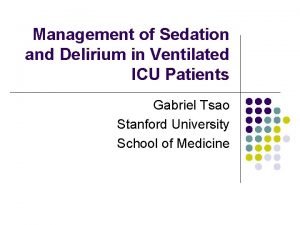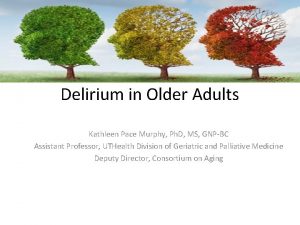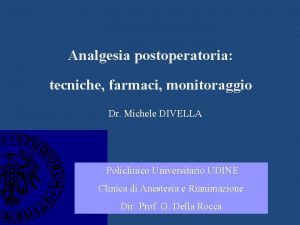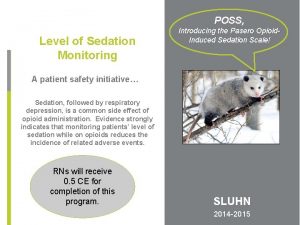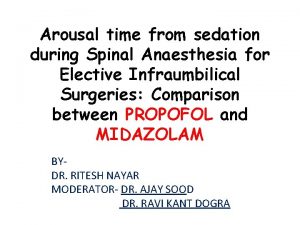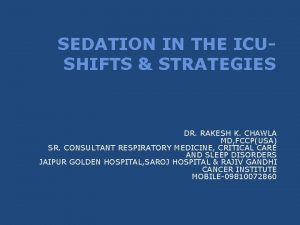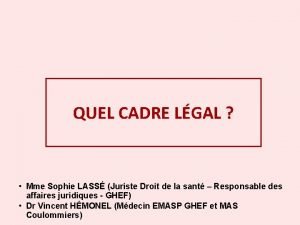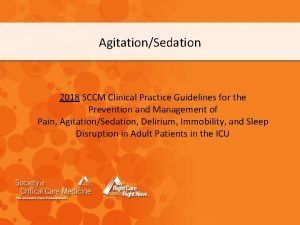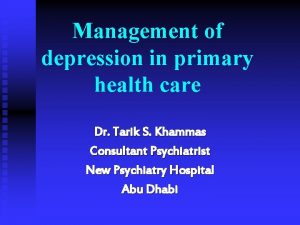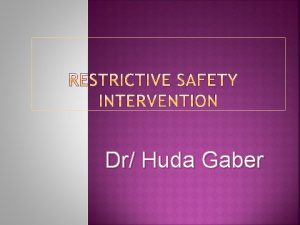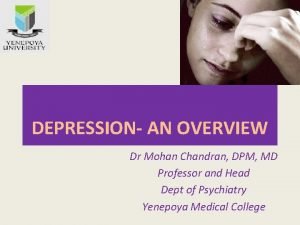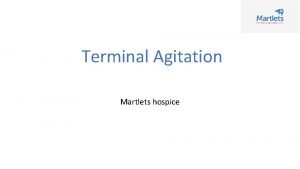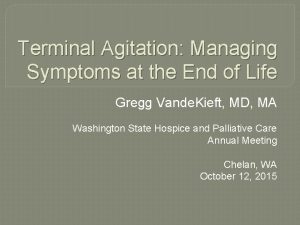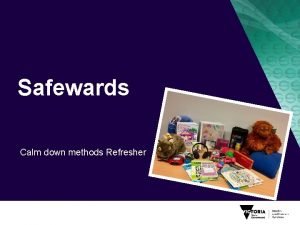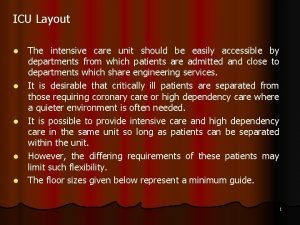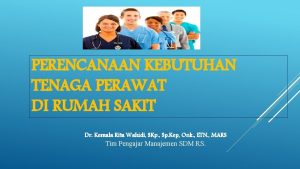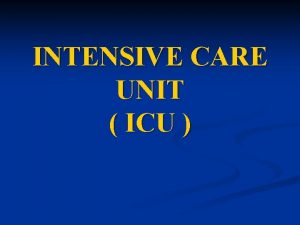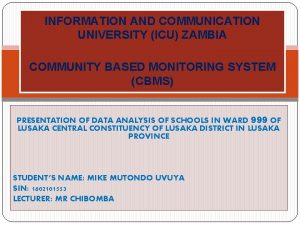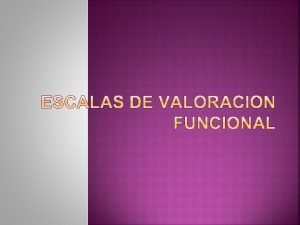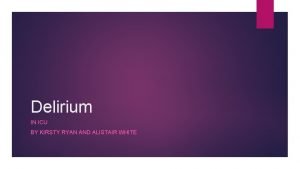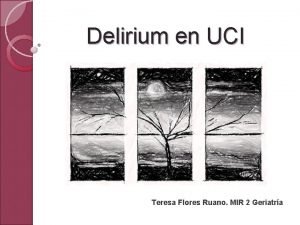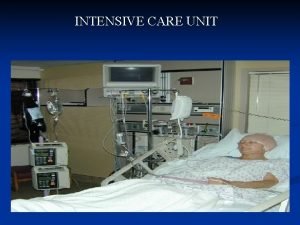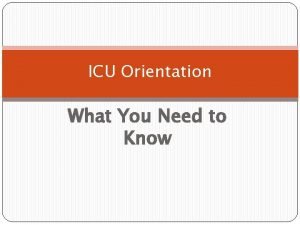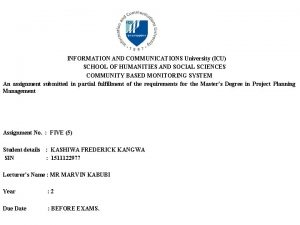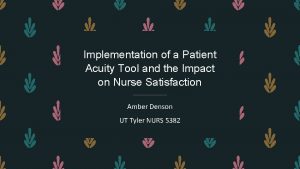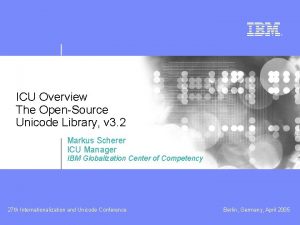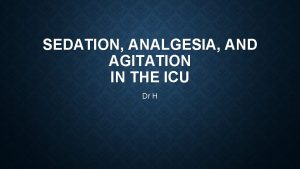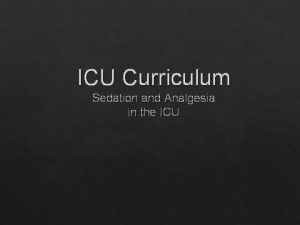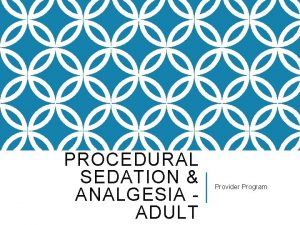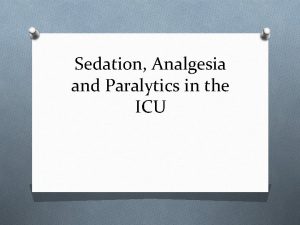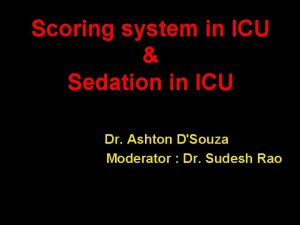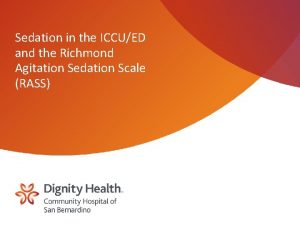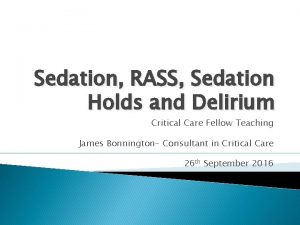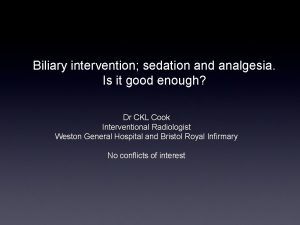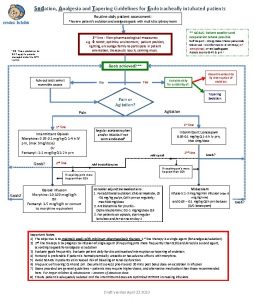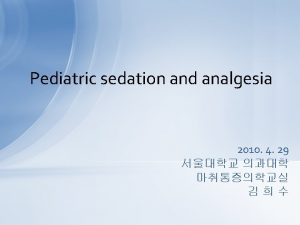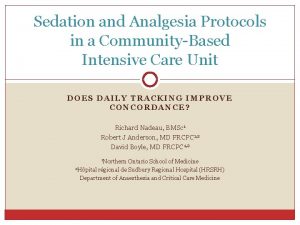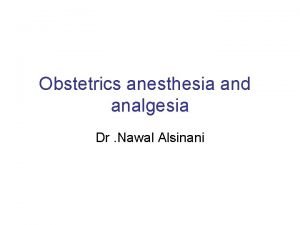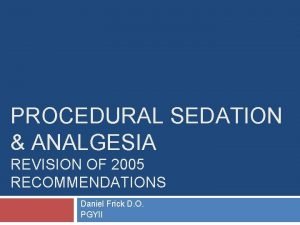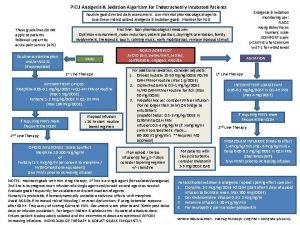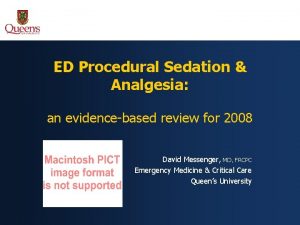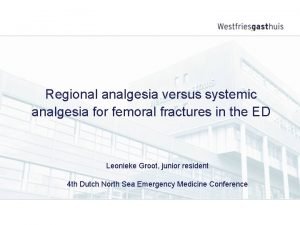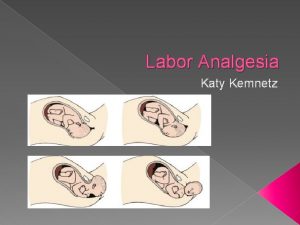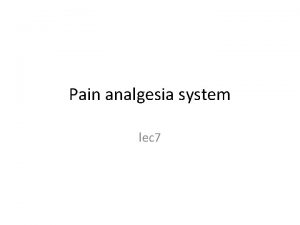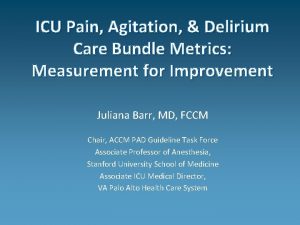SEDATION ANALGESIA AND AGITATION IN THE ICU Dr




































- Slides: 36

SEDATION, ANALGESIA, AND AGITATION IN THE ICU Dr H

OBJECTIVES • Discuss goals of sedation • Discuss nonpharmacologic interventions for distress • Discuss optimal pharmacologic interventions for distress • Discuss role of continuous infusions and daily interruptions of such

IN YOUR FREE TIME: • Devlin, et al. Clinical Practice Guidelines for the Prevention and Management of Pain, Agitation/Sedation, Delirium, Immobility, and Sleep Disruption in Adult Patients in the ICU. Critical Care Medicine: September 2018 - Volume 46 - Issue 9 - p e 825 -e 873

DISTRESS

DISTRESS • When a patient is intubated and having procedures performed on them, it can cause significant distress • Many patients have a level of delirium present when they are critically ill • It is extremely important to not add to that delirium

DISTRESS • Anxiety • Fear of suffering, Frustration at losing control, Inability to communicate… • Pain • Mostly associated with procedures (ETT cause some discomfort, but not usually pain) • Delirium • “acute and potentially reversible impairment of consciousness and cognitive function that fluctuates in severity” • Dyspnea • Can occur when on mechanical ventilation • Neuromuscular paralysis • All patients who are paralyzed must receive continuous infusions of sedatives and opiates

ANXIETY

ANXIETY • Attempt nonpharmacologic interventions • Reassurance • Frequent communication with the patient • Regular family visits • Establishment of normal sleep cycles • Cognitive-behavioral therapies • music therapy, guided imagery, and relaxation therapy • Proven to: • Decrease time on ventilator, length of ICU stay, length of hospital stay, and incidence of delirium. • No difference in PTSD, QOL, or depression, in survivors approximately two years after randomization

MUSIC THERAPY • Chalan, et al. JAMA. 2013; 309(22): 2335 -2344 • RCT, 12 ICUs • Patient Directed Music (79. 8 min/day), Noise Cancelling Headphones (34 min/day), or Usual Care. • PDM group had an anxiety score 19. 5 points lower than usual care group (P=. 003) • PDM group also had less sedation (intensity and frequency) (P=. 05, P=. 01)

PAIN

PAIN • In the critically ill, • Visual numeric rating scale was reported to be the most feasible and discriminative in terms of evaluating pain • Consider pain when the following occur, • grimacing, writhing, or signs of sympathetic activation • tachycardia, hypertension, tachypnea, diaphoresis, and piloerection • Bolus • Preferred if possible, for example, prior to bed-side procedure (even turning the patient) • Continuous • Consider in patients who have on-going pain (such as s/p ex-lap)

The Behavioral Pain Scale (BPS) and the Critical-Care Pain Observation Tool (CPOT) are the most valid and reliable behavioral pain scales for monitoring pain in medical, postoperative, or trauma (except for brain injury) adult ICU patients who are unable to self-report and in whom motor function is intact and behaviors are observable. (B).

The Behavioral Pain Scale (BPS) and the Critical-Care Pain Observation Tool (CPOT) are the most valid and reliable behavioral pain scales for monitoring pain in medical, postoperative, or trauma (except for brain injury) adult ICU patients who are unable to self-report and in whom motor function is intact and behaviors are observable. (B).

OPIATES FOR PAIN • Fentanyl is preferred • Virtually devoid of histamine-releasing properties • Does not cause profound changes in blood pressure • Quickest onset, though shorter half-life • Not affected by renal insufficiency • Usually start with 25 mcg

OTHER PAIN MEDICATIONS • Acetaminophen • NSAIDs • ketorolac! 30 mg IVP • Caution in renal insufficiency • Avoid in GI bleeds • Careful in Cardiac Patients • Gabapentin or Carbamazepine • Useful for neuropathic pain (such as in GBS) • Ketamine? • Consider local anesthetics • Regional Nerve Blocks for rib fractures • AVOID meperidine

ADJUNCTS TO PAIN MEDICATIONS • Massage √ • Music √ • Relaxation Techniques √ • Cold Therapy √ • Ice pack applied for 10 minutes applied to chest tube prior to removal • Hypnosis Ø

SEDATION

The Richmond Agitation. Sedation Scale (RASS) and Sedation-Agitation Scale (SAS) are the most valid and reliable sedation assessment tools for measuring quality and depth of sedation in adult ICU patients (B).

The Richmond Agitation-Sedation Scale (RASS) and Sedation. Agitation Scale (SAS) are the most valid and reliable sedation assessment tools for measuring quality and depth of sedation in adult ICU patients (B).

SEDATION • DEPTH OF SEDATION • Maintain light levels of sedation (decreased ICU LOS and decreased duration of mechanical ventilation) unless clinically contraindicated • Use either propofol or dexmedetomidine over benzodiazepines for sedation in critically ill, mechanically ventilated adults • Some evidence that dexmedetomidine is better than propofol given that the patient can interact and thus will have decreased delirium

SEDATION • Dexmedetomidine • 0. 2 -1. 4 mcg/kg/h • Centrally-mediated sympatholytic, sedative, and analgesic effects (selective a-2 adrenergic agonist) • Propofol • 5 -50 mcg/kg/min • Induces hypnosis • Benzodiazepines • Midazolam: 0. 02 -0. 05 mg/kg q 10 -15 min • Enhances GABA effects

DEXMEDETOMIDINE VS MIDAZOLAM • Riker et al. JAMA. 2009; 301(5): 489 -499. • Prospective, double-blind, randomized trial conducted in 68 centers in 5 countries including 375 patients • Dexmedetomidine (0. 2 -1. 4 µg/kg per hour [n=244]) or midazolam (0. 02 -0. 1 mg/kg per hour [n=122]) titrated to achieve light sedation (RASS scores between − 2 and 1) from enrollment until extubation or 30 days. • Sedation levels & ICU LOS were similar 77. 3% vs 75. 1% (P=0. 18); 5. 9 days vs 7. 6 days (P=. 24). • Decreased delirium 54% of Dex vs 76. 6% Mid (P=0. 001). • Shorter time on mechanical ventilation 1. 9 vs 5. 6 days (P=. 01), • Increased incidence of bradycardia, but did not require treatment

DEXMEDETOMIDINE VS MIDAZOLAM OR PROPOFOL • Jakob et al. JAMA. 2012; 307(11): 1151 -1160 • Two phase 3 multicenter, randomized, double-blind trials • Sedation with dexmedetomidine, midazolam, or propofol; daily sedation stops; and spontaneous breathing trials. • (midazolam, n=251, vs dexmedetomidine, n=249; propofol, n=247, vs dexmedetomidine, n=251) • Duration of mechanical ventilation • Shorter in Dex than Mid 123 vs 164 hrs (P=0. 03) • No difference in Dex vs Prop 97 vs 118 (P=0. 24) • Interactive Patient • Increased vs both Mid and Prop (P=0. 001 and P=0. 001) • ICU LOS and Mortality unchanged • More hypotension and bradycardia • Also found to be superior vs lorazepam Pandharipande et al. JAMA. 2007; 298(22): 2644 -2653

BOLUS SEDATION • StrØm et al. Lancet 2010; 375: 475– 80 • Bolus sedation allowed for more days without ventilation (mean difference 4· 2 days, 95% CI 0· 3– 8· 1; p=0· 0191). • Bolus sedation shortened ICU and hospital stay (p=0· 0316, p=0· 0039) • No difference in accidental extubations, the need for CT or MRI brain scans, or ventilator-associated pneumonia.

DAILY INTERRUPTION OF SEDATION • Kress, et al. N Engl J Med 2000; 342: 1471 -7. • RCT of 128 patients • Duration of mechanical ventilation 4. 9 days vs 7. 3 days (P=0. 004) • ICU LOS 6. 4 days vs 9. 9 days (P=0. 02) • No statistical difference in self-extubation

DELIRIUM

DELIRIUM RISK FACTORS • Modifiable • Benzodiazepine use • Blood transfusions • Nonmodifiable • Greater age • Dementia • Prior coma • Pre-ICU emergency surgery or trauma • Higher APACHE/ASA scores

LONG-TERM COGNITIVE IMPAIRMENT AFTER CRITICAL ILLNESS • Pandharipande et al. N Engl J Med 2013; 369: 1306 -1316 • Of the 821 patients enrolled • Delirium developed in 74% • A longer duration of delirium was independently associated with worse global cognition at 3 and 12 months (P=0. 001 and P=0. 04, respectively) and worse executive function at 3 and 12 months (P=0. 004 and P=0. 007, respectively). • Use of sedative or analgesic medications was not consistently associated with cognitive impairment at 3 and 12 months. • At 3 months, 40% of the patients had global cognition scores that were 1. 5 SD below the population means (similar to scores for patients with moderate traumatic brain injury) • At 3 months, 26% had scores 2 SD below the population means (similar to scores for patients with mild Alzheimer's disease). • At 12 months, 34% had scores similar to moderate TBI and 24% had scores similar to mild Alzheimer’s.

The Confusion Assessment Method for the ICU (CAM-ICU) and the Intensive Care Delirium Screening Checklist (ICDSC) are the most valid and reliable delirium monitoring tools in adult ICU patients (A).


DELIRIUM PREVENTION • We recommend performing early mobilization of adult ICU patients whenever feasible to reduce the incidence and duration of delirium • Avoid benzodiazepines • Ensure nonpharmacologic strategies are in place • Reassurance • Frequent communication with the patient • Regular family visits • Establishment of normal sleep cycles • Cognitive-behavioral therapies DO NOT ADMINISTER DRUGS TO PREVENT DELIRIUM (only to treat) e. g. haloperidol, atypical antipsychotics, dexmedetomidine, HMG-Co. A, or ketamine

EARLY MOBILITY • We suggest performing rehabilitation or mobilization in critically ill adults • Rehabilitation is a “set of interventions designed to optimize functioning and reduce disability in individuals with a health condition” • Mobilization is a type of intervention within rehabilitation that facilitates the movement of patients and expends energy with a goal of improving patient outcomes • Vasoactive infusions or mechanical ventilation are not barriers to initiating rehabilitation/mobilization, assuming patients are otherwise stable with the use of these therapies. • Major indicators for stopping rehabilitation/mobilization include development of new cardiovascular, respiratory, or neurologic instability. • Other events, such as a fall or medical device removal/malfunction, and patient distress are also indications for stopping. Denehy et al. Ten Reasons why ICU patients should be mobilized early. Intensive Care Med 2017; 43: 8690

CIRCADIAN RHYTHM REPORTED FACTORS DISRUPTIVE TO SLEEP

CIRCADIAN RHYTHM • Use assist-control ventilation at night (vs pressure support ventilation) for improving sleep in critically ill adults √ • Do not use aromatherapy, acupressure, or music at night to improve sleep in critically ill adults Ø • Use noise and light reduction strategies to improve sleep in critically ill adults √ • Do not use propofol to improve sleep in critically ill adults Ø • We make no recommendation regarding the use of melatonin to improve sleep in critically ill adults • Ramelteon has been shown to reduce occurrence of delirium • 8 mg at 20: 00

ATYPICAL ANTIPSYCHOTICS • Devlin, et al. Crit Care Med 2010 Vol. 38, No. 2. • Prospective, randomized, double-blind, placebo-controlled study of 36 pts • Patients were randomized to receive quetiapine 50 mg every 12 hrs or placebo. • Quetiapine was increased every 24 hrs (50 to 100 to 150 to 200 mg every 12 hrs) if more than one dose of haloperidol was given in the previous 24 hrs • Quetiapine Arm: • • • Shorter time to first resolution of delirium 1 vs 4. 5 days(p =0. 001) Reduced duration of delirium 36 vs 120 hrs (p= 0. 006)] Less agitation 6 vs. 36 hrs (p= 0. 02) (but more somnolent) • Mortality, ICU LOS, QTc prolongation the same.

PARALYSIS • All patients on paralytics must be on continuous infusions of pain and sedative medications. There are NO exceptions. • Bispectral index (BIS) monitoring appears best suited for sedative titration during deep sedation or neuromuscular blockade
 Dexmedetomidine dose
Dexmedetomidine dose Richmond agitation sedation scale
Richmond agitation sedation scale Analgesia sistemica
Analgesia sistemica Bromage scale
Bromage scale Rass vs poss
Rass vs poss Over-sedation
Over-sedation Riker scale
Riker scale Sédation
Sédation Sccm padis guidelines
Sccm padis guidelines Size separation slideshare
Size separation slideshare Psychomotor retardation
Psychomotor retardation Land agitation
Land agitation What is psychomotor agitation
What is psychomotor agitation Chandran cyclothymia
Chandran cyclothymia Project beta agitation
Project beta agitation What is terminal restlessness
What is terminal restlessness Terminal agitation
Terminal agitation Safewards calm down methods
Safewards calm down methods Icu layout and design
Icu layout and design Kebutuhan tenaga perawat
Kebutuhan tenaga perawat Escala de rass
Escala de rass Icu localization
Icu localization Alat icu level tertinggi
Alat icu level tertinggi Information and communications university zambia
Information and communications university zambia 5hs and 5ts
5hs and 5ts Pressors icu
Pressors icu Cam icu escala
Cam icu escala Cam icu
Cam icu Cam icu escala
Cam icu escala Cheetah nicom monitor
Cheetah nicom monitor Pearl abcde
Pearl abcde Icu unit meaning
Icu unit meaning Icu orientation
Icu orientation Icu for dummies
Icu for dummies List of lecturers at icu zambia
List of lecturers at icu zambia Patient acuity tool
Patient acuity tool Icu library
Icu library
